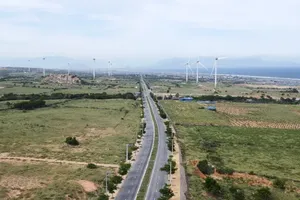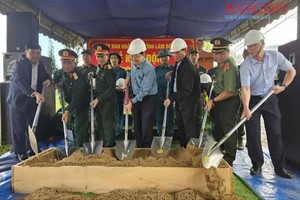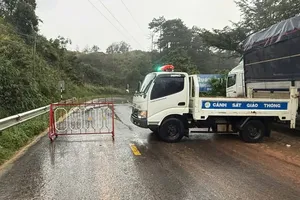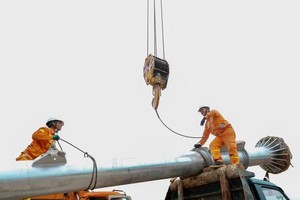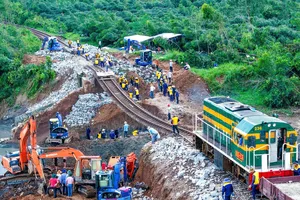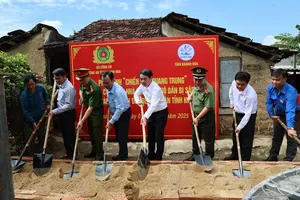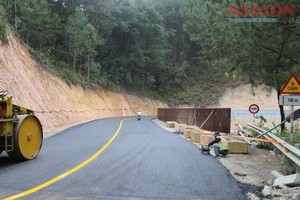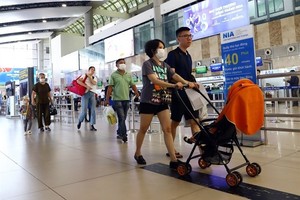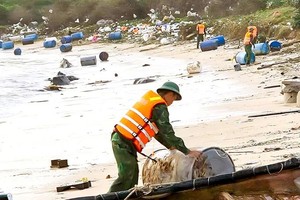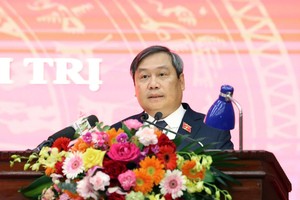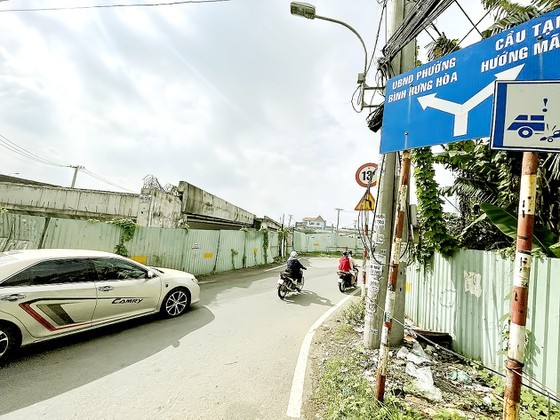 Outside of the Tan Ky - Tan Quy construction site
Outside of the Tan Ky - Tan Quy construction site
Capital bottlenecks, the projects came to a standstill
The Law on Investment in Public-Private Partnership (PPP) 2020 and several other legal documents such as Resolution 437 issued in 2017 by the National Assembly have many strict regulations to better ensure the interests of investors and the State. The law regulates that only build-operate-transfer (BOT) contracts will be implemented for new construction traffic projects and the implementation of the build- transfer contracts must stop.
According to many experts, because the enforcement capacity in many ministries, sectors and localities has been limited; as a result, many investment projects are short of capital leading to the suspension of many unfinished traffic works.
The construction site of the Tan Ky - Tan Quy 2 bridge in Ho Chi Minh City’s Binh Tan District was empty. Inside the fence to protect the work, construction materials such as iron, steel, and drainage pipes lie scattered and rusty. Parts that have been built such as pedestrian bridges, and the bridge that has crossed Tham Luong - Ben Cat canal turned gray.
Many people living around wondered whether the bridge is almost finished, and why workers have not built it lately. Meanwhile, the iron bridge that was temporarily built to serve people traveling during the construction period has deteriorated in many places and is very dangerous.
Often carrying goods on Tan Ky - Tan Quy road, driver Do Trieu Vu said that when the new steel bridge was put into use, he still drove by it. But recently, because he has felt that the steel bridge vibrated when he drove through it; subsequently, he had to drive on another route making a detour.
The construction project of the Tan Ky - Tan Quy bridge was started 4 years ago, in the form of BOT. When the work was done about 70 percent of the volume, the work was suspended because the construction was not consistent with the National Assembly’s Resolution 437/2017 which only implemented BOT on new roads.
Similarly, although each bridge has been divided into lanes for one-way traffic to reduce traffic congestion through the Binh Trieu 1 and Binh Trieu 2 bridges, vehicles are still seen to queue up in a long line on the two bridges because the roads around Binh Trieu 1 and 2 bridges are small and can’t meet the flow of traffic. The expansion of the surrounding road can’t be implemented because this project is implemented in the form of BOT against the National Assembly’s Resolution 437/2017; therefore, the construction of the two bridges must be suspended.
As for many projects that have not been implemented, the difficulty lies elsewhere. Due to its important role in the development of Ho Chi Minh City and the southwestern provinces, the high-speed railway Ho Chi Minh City - Can Tho project with an investment of about US$7 billion has just been approved by the Ministry of Transport and other localities and relevant agencies which planned to implement it before 2030 instead of after 2030.
However, according to Associate Professor Nguyen Anh Tuan from the University of Transport of Ho Chi Minh City, one of the experts taking part in the in-depth research on this project, $7 billion is a large amount, and the state budget is very difficult to arrange in the current context meanwhile ODA loans are impossible because most countries in the world are still struggling to recover from the pandemic whereas it is unfeasible to calling for private investors pouring money into the project in the form of BOT, with an estimated payback period of at least more than 30 years. So, although the project is expected to be finished soon, it is unclear when the project will start.
The associate professor added that currently, Ho Chi Minh City and localities where the railway line passes such as the Mekong Delta provinces of Long An, Tien Giang, Vinh Long and Can Tho City have planned hundreds of hectares of urban development around stations on the route which are the ‘gold mines’ can be exploited to create capital for railways.
However, according to a preliminary survey, many localities are still facing many difficulties after the pandemic; therefore, they do not have enough human and material resources to implement meanwhile the PPP Law doesn’t allow the allocation of land to investors to exploit in exchange for land for infrastructure, said Associate Professor Nguyen Anh Tuan.
Need a flexible mechanism
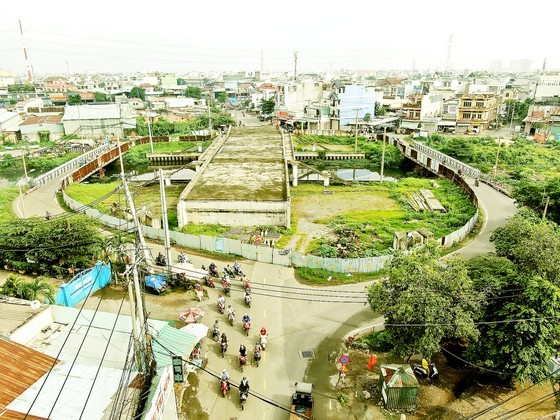 The construction site of Tan Ky - Tan Quy bridge
The construction site of Tan Ky - Tan Quy bridge
Not only in Ho Chi Minh City but many other localities and ministries also have many BOT projects that have to be suspended from construction to convert to appropriate forms as per the law. The Ministry of Transport alone has 14 projects. Currently, Ho Chi Minh City, as well as the Ministry of Transport and many other ministries have been making efforts to carry out the necessary procedures for the transformation of the form of investment in accordance with the provisions of the law.
However, the conversion procedure has no precedent without specific instructions; consequently, it takes a lot of time for determining the items that the investor has done to have a payment basic, so many projects have been still frozen, not to mention road improvement projects in the inner city which the payback fee is not collected, capital from the budget must be taken. Worse, the state budget is being spent on economic recovery and supporting people after the epidemic.
In this context, many economic experts said that it is necessary to diversify forms of investment according to the PPP method. Specifically, in addition to traditional PPP forms such as BOT, it is necessary to focus on calling for private investment in the form of Build-Transfer-Lease (BTL) contracts or Build, lease, transfer (BLT) contracts (a contract signed between a competent state agency and an investor or enterprise).
After completing the work, the investor or the enterprise shall transfer the work to a competent state agency and have the right to provide operation and exploitation services for that facility within a certain period. The competent state agency is the party that hires the service and pays the project owner and enterprise.
Accordingly, the investor will be responsible for investment, construction, operation, maintenance, and repair and the state pays the investor an annual fee during the contract term. This expenditure ( or service rent) is derived from public service revenue or local budget capital, or a combination of the two kinds.
The form of BTL or BLT contracts can be applied to works that can’t collect fees directly from users such as drainage systems, urban roads, government offices, dikes, and embankments. Besides, in order to shorten the preparation time ( or a prefeasibility study) and control the total investment capital for the transparency of PPP projects, localities need to soon establish an investment preparation support fund. At the same time, it is necessary to establish a Financial Compensation Fund (VGF) to provide financial support for PPP projects.
Many experts also believed that legal regulations should not be applied retroactively to PPP projects that have been implemented before. State management agencies need to consider carefully, specifically, understandably, and rationally PPP projects.
Careful consideration should be given to the early promulgation of legal regulations guiding the implementation of the PPP Law to specific and different characteristics and situations in each region and region, especially in large and densely populated urban areas such as Ho Chi Minh City.
To generate more capital for development and create a land fund to invest in infrastructure projects, the Real Estate Association of Ho Chi Minh City (Horea) petitioned that the provisions in the Land Law should be supplemented to be consistent with other laws; for instance, Law of Urban planning and the Law on Management and Use of Public Property. If this is well done, it will help to resettle in place, as well as soon stabilize life for people whose land is acquired; thereby, the implementation of site clearance work will be carried out faster.
It is necessary to perform more effectively the auction of land use rights, bidding for projects using land for the remaining land area according to the planning in order to select good investors.
According to the transport infrastructure investment plan for the 2021-2030 period, Ho Chi Minh City needs VND970,654 billion (US$ 41,7 billion) to implement key projects. However, with the current tight budget capital, the city needs to have a specific mechanism and a new way of doing things to meet the urgent needs of people and businesses.
